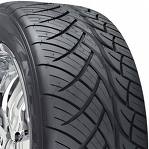
|
B arry's
Tire
Tech This is a series of articles on the technical aspects of tires, their care and usage. My primary purpose in these articles is to help people understand tires and thereby reduce the risks we all face every day. ..........and since tires is just about the only thing I know about.......... Please drop me a note if you have a topic you want to see: Barry@BarrysTireTech.com |
|
Directional and Asymmetrical Tires: |
|
Revised: December, 2024 At the bottom of this page, see the additon of Tyre Reviews Video (Jonathan Benson). I get a lot of questions about these kinds of tires. It's pretty simple - REALLY! |
|
Directional Tires will have an arrow on the sidewall. If it doesn't have an arrow, it's non-directional! and it doesn't matter which way it rotates. Directional tires are primarily about wet traction - although snow traction is sometimes the intent in the design. As a general rule, directional tires will have an "arrowhead-like" tread pattern - it seems to point in the direction of travel.If you mount a directional tire backwards - so that it is rotating the wrong direction - the only problem caused is wet (or snow) traction. It does not affect wear, pull, dry traction, ride, or any other characteristics. If you have one of those problems, then the problem has nothing to do with the direction of rotation of the tires. If you are mounting directional tires on rims, you want 2 tires pointing one direction, and 2 tires pointing the other direction. Directional tires can only use a front to back rotation pattern - no switching the tire to the other side. CAUTION: Some rims are also directional, so a little care before doing any work will pay many benefits. |

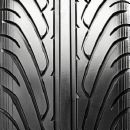
|
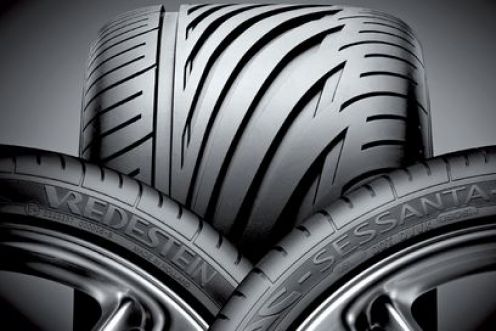
|
Sometimes it appears that a tire has a direction to it, but it doesn't have an arrow - like the tire to the left. While this tire seems to be directional, it doesn't matter which direction it travels - and I'll explain that in a minute. Let me say it again: If it doesn't have an arrow, it is not directional! |
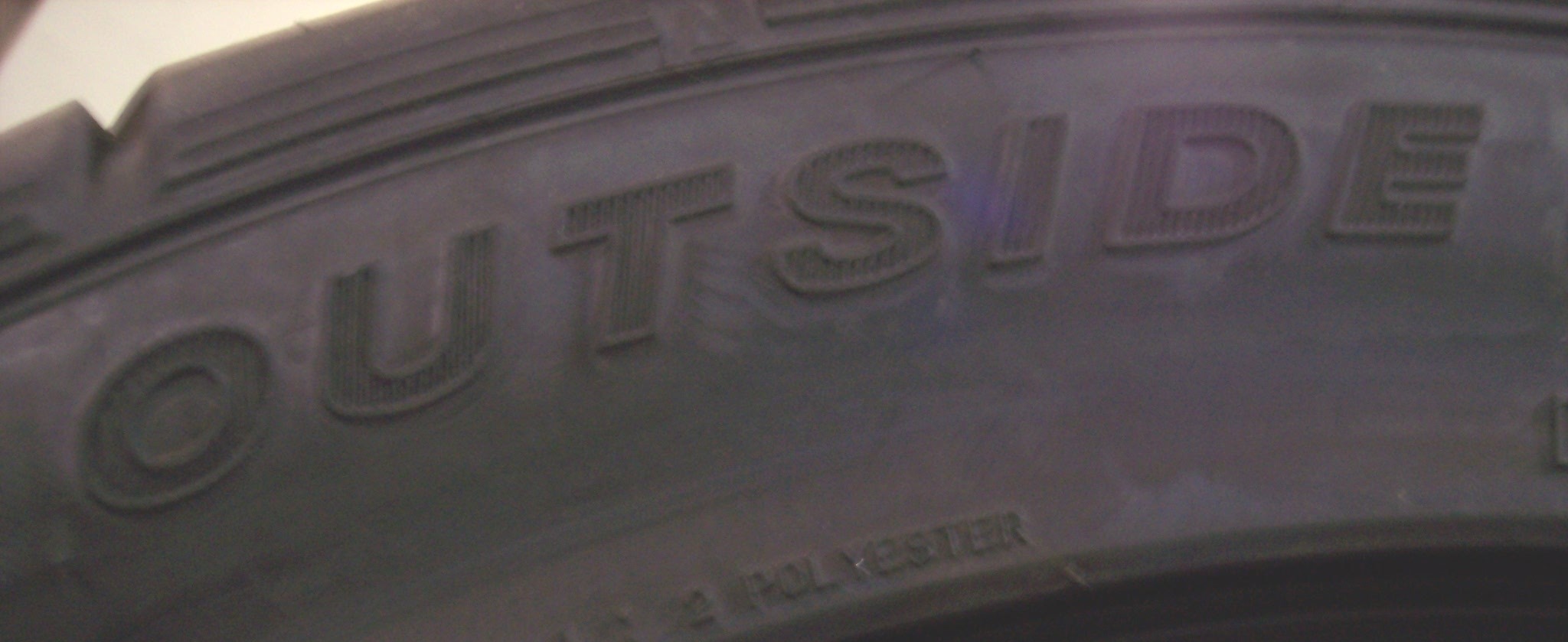
|

|
|
Asymmetrical Tires are those that the tread pattern on one side is different than the other side. They will always have something on the sidewall that says "THIS SIDE OUT" - or words to that effect. The purpose of using asymmetry in a tread pattern is to allow the tire to be pretty good at 2 conflicting things. The tire to the right has large blocks, which are good for dry traction, and small blocks, which are good for wet and snow traction. Obviously, the large blocks should be on the outside.Both asymmetrical and symmetrical tires can be cross rotated - meaning basically there are no restrictions as to what rotation pattern you CAN use. However, my experience says that some form an "X" pattern is best. If doesn't say "THIS SIDE OUT", then it is not asymmetrical and it doesn't matter which side is out. Put another way - it is symmetrical. |

|
I hope everyone will cut me some slack about the following drawings. I'm not an artist and I have limited tools to work with. Besides, the whole point is to demonstrate a principle - not have beautiful, but incomprehensible, artwork. The image to the left is a drawing I made to try to demonstrate some things about tread patterns. It is supposed to represent the tread pattern of a symmetrical tire. The black part is where the tread hits the road surface and the white is where there are grooves, sipes, etc. A symmetrical tire is the same no matter how the tire is oriented. Don't believe me? Turn the image upside down and look for yourself! |
| The drawing to the right is exactly the same image as the one above - it has the same width, the same width grooves, the same angles to the cross grooves, the same width of the ribs - everything except I reoriented the cross grooves in the form of a "V" - and that makes it directional. |
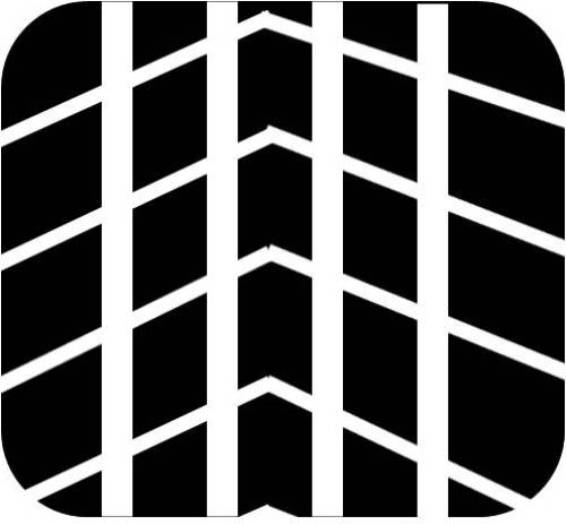
|
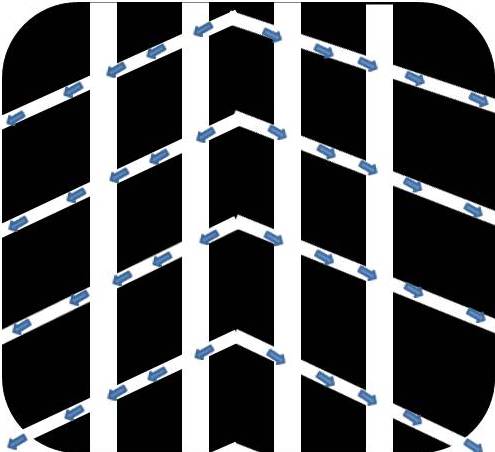
|
I have now added blue arrows to indicate the direction the water will take. Notice it flows away from the center and out of the footprint - just as advertised. |
|
In the drawing to the right, I've split the pattern into 2 halves. The left side
is the same as above, but on the right side I moved a single row of ribs - such that
the path of the water is blocked every time it exits into a groove.
That means that for the water to be pumped out of the footprint, it has to travel down
the groove a little ways before it encounters another cross groove and can continue
its path to the edge of the footprint.
It should be obvious that even though the tread pattern is directional, its ability
to pump water out from the middle of the footprint is severely compromised. You
could even argue that the pattern is such that - for practical purposes - the
pattern completely lost its ability to do what was intended and that it might as well
be a non-directional pattern.
And that, my friends, happens all too often. But the opposite is also true. There are tires that are not labeled as directional and there is directionality to the pattern. The only thing I can say about these situations is that if it has an arrow on the sidewall, you'll have to assume it is directional - and if it doesn't, you'll have to assume it isn't. |
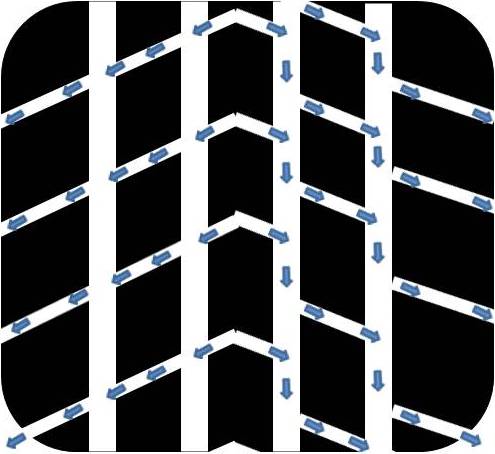
|

|
Now let's tackle asymmetry. To the left is the same basic tread pattern I started with - except I moved the grooves a bit to the left - the tire is now asymmetrical. Obviously the right side of the pattern has larger blocks - which, in theory, would improve dry grip. I think it is less obvious that the left side of the pattern would be better (than before) for wet traction (resistance to hydroplaning). The question is whether this tire would have better overall performance. |
|
So let me ask this question: Do any of the tires below have any real performance differences - OVERALL!! |

|

|

|
| I contend that the only way a tire would benefit from asymmetry is if the car had a lot of roll and the pressure distribution of the tire changes as the tire corners - and frankly I don't think this kind of compromise works very well unless that happens. So why worry about great cornering power when your car is compromised by a lot of roll! If you take this to mean that I am not a fan of asymmetrical tires - you are right! But I am also not a fan directional tires! |

|
In the early days of directional tires, Goodyear produced a tire called the Aquatred. It was a directional tire with a groove down the center. The claim was that is greatly improved wet traction. To understand how much improvement this was, the company I worked for tested the Aquatred rotating in both directions. There was a 10% difference - meaning there would only be a 5% difference if the tread pattern was non-directional. I think this means that only a trained observer - like a race car driver - could feel and take advantage of the difference! |
| In my opinion, while directional and asymmetrical tires look sexy and high tech, I don't think the average motorist can take advantage of the small amount of performance improvements they really have. |
|
Revised: December, 2024 In November, 2024, Jonathan Benson posted a new video on his YouTube Channel, Tyre Reviews: What happens if you mount a tire backwards. In it he tests a Pirelli Cinturato All Season SF3s- an All Weather (3PMSF) tire - both frontwards and backwards in a variety of conditions. Short Version: Mounting this tire backwards hurts some performance, but only a little. Here's a link to the video: YouTube: Tyre Reviews: What happens if you mount a tire backwards? This video validates what I said earlier about non-directional tires being good enough that only an expert can find the difference. Barry's Tire Tech - Main Page |